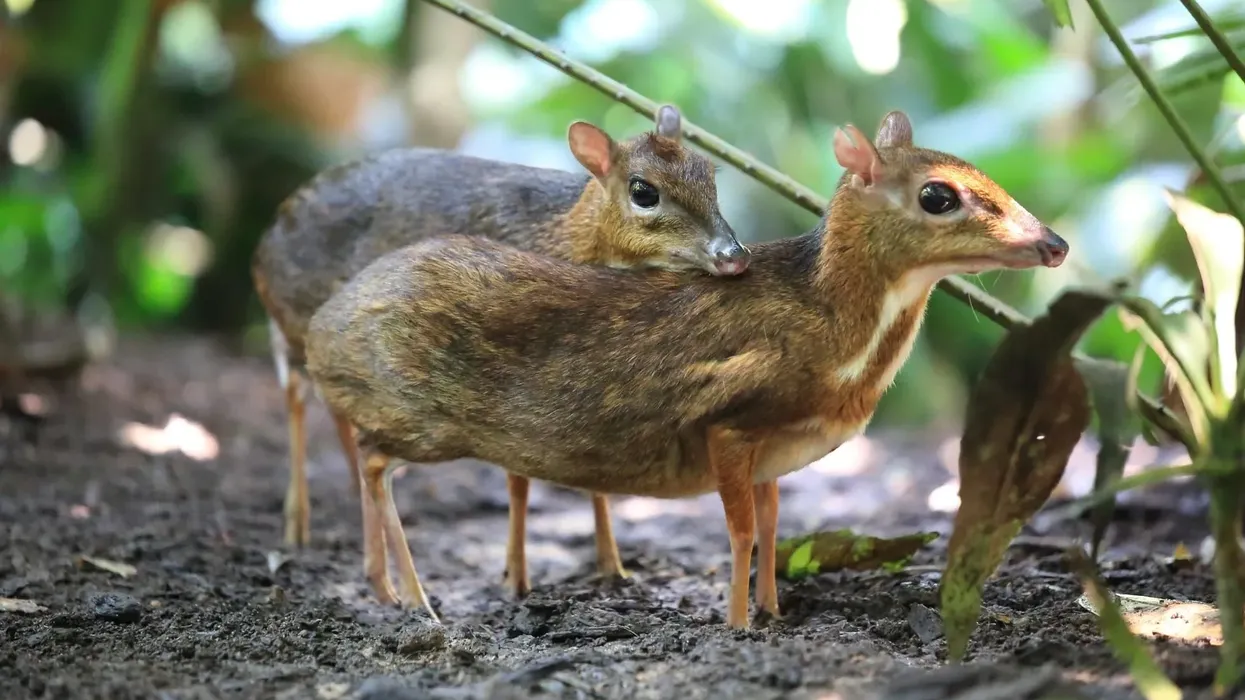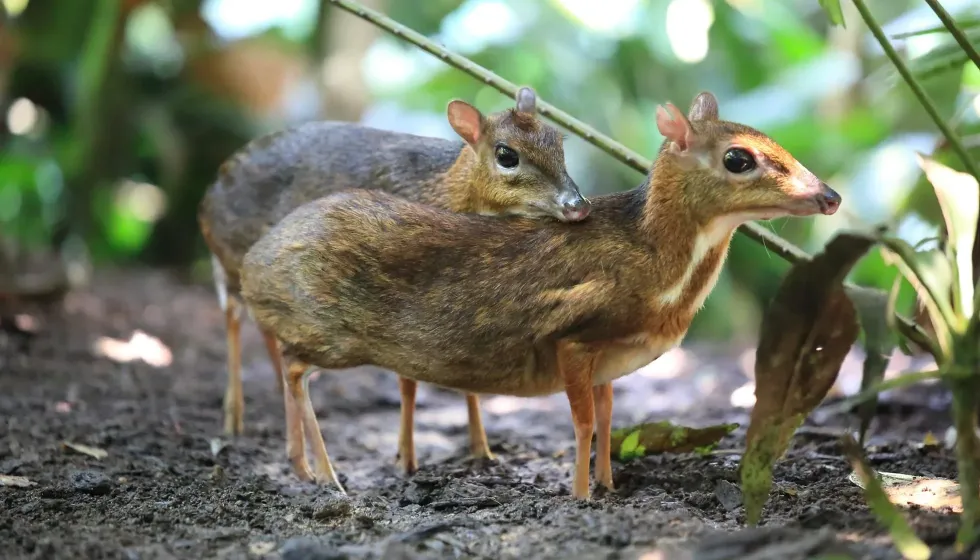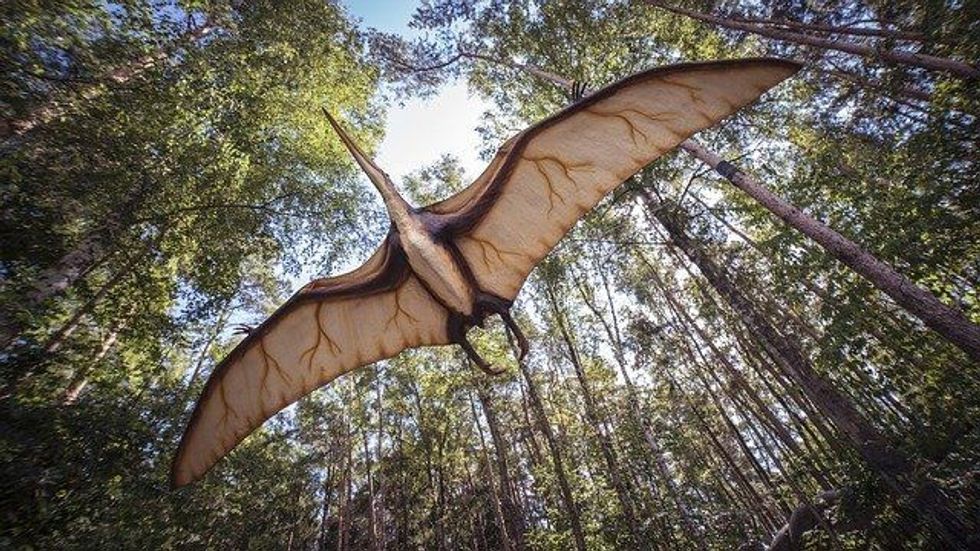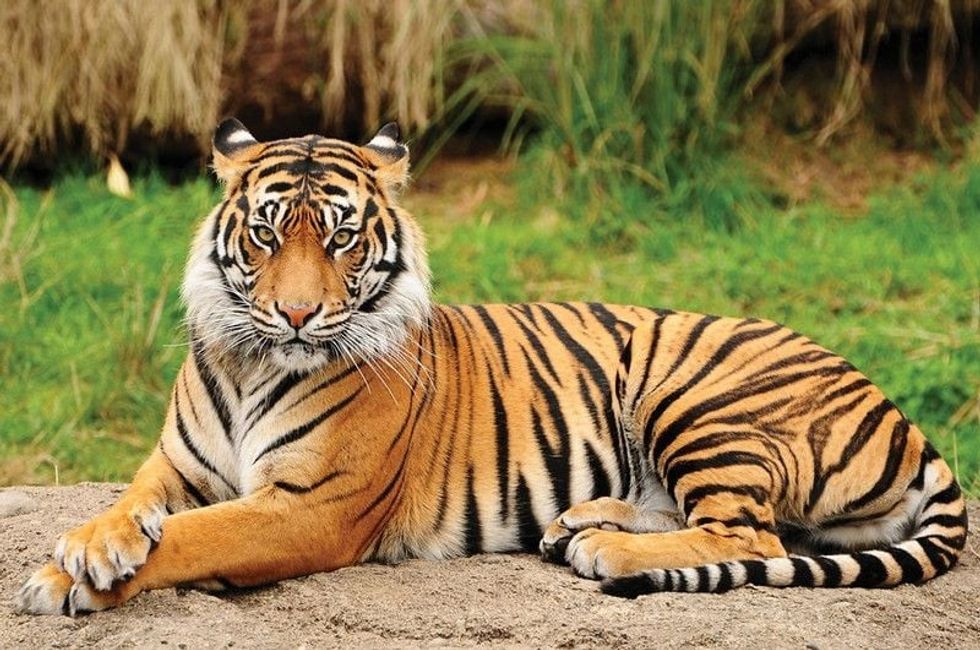The silver-backed chevrotain (Tragulus versicolor) is a species of mouse-deer found only in Vietnam.
First discovered in 1910 when four specimens from Nha Trang in Annam were collected, there is not much information on the behavior and distribution of this species.
In 1990, this species was last seen in Dak Rong and Buon Luoi in the Gia Lai province of Vietnam, according to a study published in the journal Nature Ecology and Evolution.
However, due to habitat degradation and frequent hunting, chevrotains soon became a lost species according to researchers behind the discovery and the IUCN later deemed the status of this animal as Data Deficient in 2008.
However almost after 30 years in 2019, with the help of photos by camera traps, the presence of silver-backed chevrotains was confirmed by scientists and researchers (An Nguyen from GWC and Leibniz and his team) in dry low-lying forests of southern Vietnam.
The population is still unknown.
A silver-backed chevrotain is also known as a Vietnam mouse-deer. This species is recognized by a rough coat with a strange double-tone coloration and the back has a silver line. The species closely resembles the lesser mouse-deer. The Vietnamese mouse-deer has white and dark red-brownish marks on the throat.
For more relatable content, check out these auroch facts and takins fun facts.
Silver-Backed Chevrotain Interesting Facts
What type of animal is a silver-backed chevrotain?
A silver-backed chevrotain (Tragulus versicolor) is a mouse-deer from Vietnam. This species is a part of group of even-toed ungulates that also has members like deers, pigs, antelopes, llamas, goats, hippopotamus, giraffes, and camels.
What class of animal does a silver-backed chevrotain belong to?
The silver-backed chevrotain falls under the class of Mammal in the kingdom of Animalia.
How many silver-backed chevrotains are there in the world?
The population of this Vietnamese species is not known.
Where does a silver-backed chevrotain live?
Found in the Southeast Asian forests, this species is native to Vietnam. They are found on the southern coast of the country currently.
What is a silver-backed chevrotain's habitat?
The silver-backed chevrotain prefers a habitat of semi-deciduous tropical forest and dry lowland forest. This species is also diurnal and seen only during the day.
Who do silver-backed chevrotains live with?
Silver-backed chevrotains are known to live both in solitary and in pairs.
How long does a silver-backed chevrotain live?
The lifespan of this species is not known.
How do they reproduce?
Not much is known about silver-backed chevrotains, however hey are probably similar to other species of chevrotains.
Chevrotains are known to give birth to one single young and parental care is limited in this species. Weaning is done at about three months after birth. Sexual maturity is reached at five to nine months of age.
What is their conservation status?
The conservation status of silver-backed chevrotains (Tragulus versicolor) is categorized as Data Deficient by the IUCN Red List. The numbers are known to be decreasing currently and if not controlled, the problems for this species could grow in the near future. Hunting and habitat loss due to deforestation and degradation are known to be the main causes.
Pictures of silver-backed chevrotain specimens were captured by a camera trap placed in the forest just recently in 2019. This was enough evidence for scientists and researchers to conclude that these animals are still present in the ecology and have not gone extinct as previously declared.
Silver-Backed Chevrotain Fun Facts
What do silver-backed chevrotains look like?
The body of a silver-backed chevrotain has a touch coat with a strange two-tone coloration. The back part of the body is colored gray which contrasts well with the reddish-brown front. A white and dark reddish-brown color is seen on the throat and this species has big reddish-brown ears.
A distinct silver line can be seen running down the back. The tail is gray above and white below and turns reddish-brown towards the tip. The tip of the tail is white.
Silver-backed chevrotain fangs are longer in males. Although there is not much information published, many believe that the silver-backed chevrotain fangs on males are used to compete for mates and territories in nature.

*Please note that this is an image of a Java mouse-deer, a species of the same genus Tragulus. If you have an image of silver-backed chevrotain please let us know at hello@kidadl.com.
How cute are they?
They are considered one of the cutest animals out there in nature.
How do they communicate?
They beat their hooves creating a drumming sound. This is used if under threat or agitated. Other communication behavior is not known.
How big is a silver-backed chevrotain?
The length of a silver-backed chevrotain as published is 18.9 in (48 cm). The tail alone is 2 in (5.08 cm) long for this group of animals.
The silver-backed chevrotain size can be considered similar to a large rabbit with a silver sheen on its rump.
How fast can a silver-backed chevrotain run?
The speed of a silver-backed chevrotain is not known.
How much does a silver-backed chevrotain weigh?
The weight of this species is near 3.74 lb (1.7 kg).
What are the male and female names of the species?
Males and females are not given different names.
What would you call a baby silver-backed chevrotain?
A baby silver-backed chevrotain is called a young.
What do they eat?
The silver-backed chevrotain diet consists mainly of plant materials and vegetation. It is rare, but chevrotains are sometimes known to feed on insects, crabs, and fish. Their predators mainly consist of large to medium-sized carnivores.
Are they dangerous?
They are not dangerous.
Would they make a good pet?
Due to little information on the population of this species of chevrotain, these animals should not be kept as pets.
Did you know...
A British zoologist named Oldfield Thomas discovered this species with the help of four adult silver-backed chevrotains collected from Nha Trang in Vietnam in 1910. Next, a population was seen in 1990 in Vietnam.
After this period, they were never seen and were deemed as a lost species. This was the case for the animal until evidence of the presence of this group of animals was found almost 30 years later in 2019 by scientists and researchers when photos were captured by camera traps.
A photo captured by the camera trap suggests that the distribution of chevrotains is restricted to dry low-lying forests in southern Vietnam. The rediscovery of this species was just concluded recently.
To know more about the scientists behind the discovery, An Nguyen is a Vietnamese biologist and scientist with GWC and also a Ph.D. student in the Leibniz Institute for Zoo and Wildlife Research. Nguyen from GWC and Leibniz and a team that included Dr. Barney Long and Andrew Tilker from GWC went out on a scientific discovery mission.
Before this, the specimen had only be spotted once in 1907.
The team from Global Wildlife Conservation along with Nguyen from Leibniz searched in different sites and regions of the forests where the camera traps were installed by the locals. The southern part of Vietnam was chosen as one location and the other was a region further north.
A photo was found soon after with the help of locals and government forest rangers.
The camera trap was put up again to capture more specimens of chevrotains by the scientists. From a single photo, 275 more photos were found by the scientists in an extraordinary rediscovery of silver-backed chevrotains.
Are silver-backed chevrotains endangered?
Although the IUCN does not recognize the species as endangered, there is a possibility that the photos and data published by Global Wildlife Conservation is the last population or one of the last populations remaining of this species.
As chevrotains have been hidden from the ecology for much of last century, scientific data of their population cannot be ascertained.
This species found in the Southeast Asian tropical forests need some conservation measures to be implemented as threats from hunters and the degradation of their habitat has become a major cause of concern.
How did the silver-backed chevrotain get its name?
A silver line is found on the back, hence the name silver-backed chevrotain.
Here at Kidadl, we have carefully created lots of interesting family-friendly animal facts for everyone to discover! For more relatable content, check out these kudu facts and key deer interesting facts for kids.
You can even occupy yourself at home by coloring in one of our free printable Silver-backed chevrotain coloring pages.









